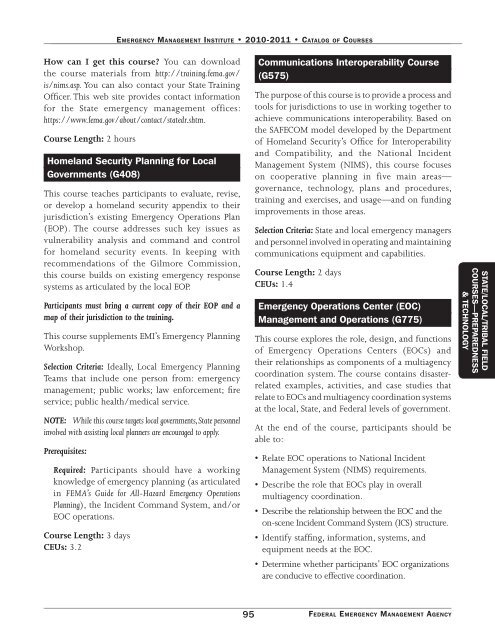enrollment for emi courses - Emergency Management Institute ...
enrollment for emi courses - Emergency Management Institute ...
enrollment for emi courses - Emergency Management Institute ...
You also want an ePaper? Increase the reach of your titles
YUMPU automatically turns print PDFs into web optimized ePapers that Google loves.
EmE r g E n c y ma n a g E m E n t In s t I t u t E • 2010-2011 • ca t a l o g of co u r s E s<br />
How can I get this course? You can download<br />
the course materials from http://training.fema.gov/<br />
is/nims.asp. You can also contact your State Training<br />
Officer. This web site provides contact in<strong>for</strong>mation<br />
<strong>for</strong> the State emergency management offices:<br />
https://www.fema.gov/about/contact/statedr.shtm.<br />
Course Length: 2 hours<br />
Homeland security planning <strong>for</strong> local<br />
governments (g408)<br />
This course teaches participants to evaluate, revise,<br />
or develop a homeland security appendix to their<br />
jurisdiction’s existing <strong>Emergency</strong> Operations Plan<br />
(EOP). The course addresses such key issues as<br />
vulnerability analysis and command and control<br />
<strong>for</strong> homeland security events. In keeping with<br />
recommendations of the Gilmore Commission,<br />
this course builds on existing emergency response<br />
systems as articulated by the local EOP.<br />
Participants must bring a current copy of their EOP and a<br />
map of their jurisdiction to the training.<br />
This course supplements EMI’s <strong>Emergency</strong> Planning<br />
Workshop.<br />
Selection Criteria: Ideally, Local <strong>Emergency</strong> Planning<br />
Teams that include one person from: emergency<br />
management; public works; law en<strong>for</strong>cement; fire<br />
service; public health/medical service.<br />
NOTE: While this course targets local governments, State personnel<br />
involved with assisting local planners are encouraged to apply.<br />
Prerequisites:<br />
Required: Participants should have a working<br />
knowledge of emergency planning (as articulated<br />
in FEMA’s Guide <strong>for</strong> All-Hazard <strong>Emergency</strong> Operations<br />
Planning), the Incident Command System, and/or<br />
EOC operations.<br />
Course Length: 3 days<br />
CEUs: 3.2<br />
95<br />
communications Interoperability course<br />
(g575)<br />
The purpose of this course is to provide a process and<br />
tools <strong>for</strong> jurisdictions to use in working together to<br />
achieve communications interoperability. Based on<br />
the SAFECOM model developed by the Department<br />
of Homeland Security’s Office <strong>for</strong> Interoperability<br />
and Compatibility, and the National Incident<br />
<strong>Management</strong> System (NIMS), this course focuses<br />
on cooperative planning in five main areas—<br />
governance, technology, plans and procedures,<br />
training and exercises, and usage—and on funding<br />
improvements in those areas.<br />
Selection Criteria: State and local emergency managers<br />
and personnel involved in operating and maintaining<br />
communications equipment and capabilities.<br />
Course Length: 2 days<br />
CEUs: 1.4<br />
<strong>Emergency</strong> Operations center (EOc)<br />
management and Operations (g775)<br />
This course explores the role, design, and functions<br />
of <strong>Emergency</strong> Operations Centers (EOCs) and<br />
their relationships as components of a multiagency<br />
coordination system. The course contains disasterrelated<br />
examples, activities, and case studies that<br />
relate to EOCs and multiagency coordination systems<br />
at the local, State, and Federal levels of government.<br />
At the end of the course, participants should be<br />
able to:<br />
• Relate EOC operations to National Incident<br />
<strong>Management</strong> System (NIMS) requirements.<br />
• Describe the role that EOCs play in overall<br />
multiagency coordination.<br />
• Describe the relationship between the EOC and the<br />
on-scene Incident Command System (ICS) structure.<br />
• Identify staffing, in<strong>for</strong>mation, systems, and<br />
equipment needs at the EOC.<br />
• Determine whether participants’ EOC organizations<br />
are conducive to effective coordination.<br />
FEd E r A L Em E r g E N C y mA N A g E m E N T Ag E N C y<br />
statE/lOcal/trIbal fIElD<br />
cOursEs—prEparEDnEss<br />
& tEcHnOlOgy

















